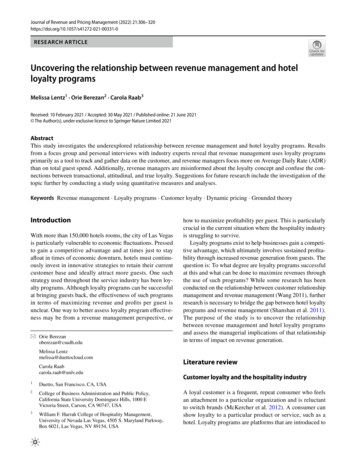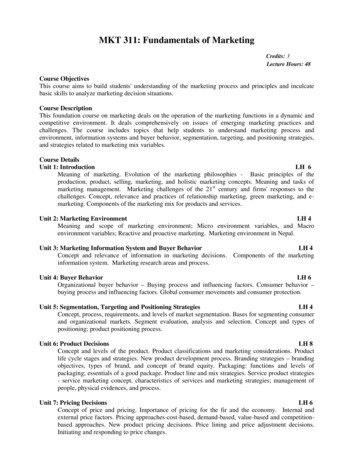
Transcription
Marketing Research:Uncovering Competitive AdvantagesWarren F. KuhfeldAbstractSAS provides a variety of methods for analyzing marketing data including conjoint analysis, correspondence analysis, preference mapping, multidimensional preference analysis, and multidimensionalscaling. These methods allow you to analyze purchasing decision trade-offs, display product positioning,and examine differences in customer preferences. They can help you gain insight into your products,your customers, and your competition. This chapter discusses these methods and their implementationin SAS. IntroductionMarketing research is an area of applied data analysis whose purpose is to support marketing decisionmaking. Marketing researchers ask many questions, including: Who are my customers? Who else should be my customers? Who are my competitors’ customers? Where is my product positioned relative to my competitors’ products? Why is my product positioned there? How can I reposition my existing products? What new products should I create? What audience should I target for my new products? Copies of this chapter (MR-2010A), the other chapters, sample code, and all of the macros are available on theWeb e marketresearch.html. This is a minor modification ofa paper that was presented to SUGI 17 by Warren F. Kuhfeld and to the 1992 Midwest SAS Users Group meeting byRussell D. Wolfinger.27
28MR-2010A — Marketing Research: Uncovering Competitive AdvantagesMarketing researchers try to answer these questions using both standard data analysis methods, suchas descriptive statistics and crosstabulations, and more specialized marketing research methods. Thischapter discusses two families of specialized marketing research methods, perceptual mapping andconjoint analysis. Perceptual mapping methods produce plots that display product positioning, productpreferences, and differences between customers in their product preferences. Conjoint analysis is usedto investigate how consumers trade off product attributes when making a purchasing decision.Perceptual MappingPerceptual mapping methods, including correspondence analysis (CA), multiple correspondence analysis (MCA), preference mapping (PREFMAP), multidimensional preference analysis (MDPREF), andmultidimensional scaling (MDS), are data analysis methods that generate graphical displays from data.These methods are used to investigate relationships among products as well as individual differencesin preferences for those products. CA and MCA can be used to display demographic and survey data. CA simultaneously displays in ascatter plot the row and column labels from a two-way contingency table (crosstabulation) constructedfrom two categorical variables. MCA simultaneously displays in a scatter plot the category labels frommore than two categorical variables.MDPREF displays products positioned by overall preference patterns. MDPREF also displays differences in how customers prefer products. MDPREF displays in a scatter plot both the row labels(products) and column labels (consumers) from a data matrix of continuous variables.MDS is used to investigate product positioning. MDS displays a set of object labels (products) whoseperceived similarity or dissimilarity has been measured.PREFMAP is used to interpret preference patterns and help determine why products are positionedwhere they are. PREFMAP displays rating scale data in the same plot as an MDS or MDPREF plot.PREFMAP shows both products and product attributes in one plot.MDPREF, PREFMAP, CA, and MCA are all similar in spirit to the biplot, so first the biplot isdiscussed to provide a foundation for discussing these methods.The Biplot.A biplot (Gabriel 1981) simultaneously displays the row and column labels of a datamatrix in a low-dimensional (typically two-dimensional) plot. The “bi” in “biplot” refers to the jointdisplay of rows and columns, not to the dimensionality of the plot. Typically, the row coordinates areplotted as points, and the column coordinates are plotted as vectors.Consider the artificial preference data matrix in Figure 1. Consumers were asked to rate their preferencefor products on a 0 to 9 scale where 0 means little preference and 9 means high preference. Consumer1’s preference for Product 1 is 4. Consumer 1’s most preferred product is Product 4, which has apreference of 6. Also see pages 1231 and 1263.
MR-2010A — Marketing Research: Uncovering Competitive Advantages YProductProductProductProduct1234 Consumer 1 4416Consumer 21202Figure 1. Preference Data Matrix29Consumer 36428 441612026428 1202B0 A2012 "2 1 21 0 2#Figure 2. Preference Data DecompositionThe biplot is based on the idea of a matrix decomposition. The (n m) data matrix Y is decomposedinto the product of an (n q) matrix A and a (q m) matrix B0 . Figure 2 shows a decomposition ofthe data in Figure 1. The rows of A are coordinates in a two-dimensional plot for the row points inY, and the columns of B0 are coordinates in the same two-dimensional plot for the column points inY. In this artificial example, the entries in Y are exactly reproduced by scalar products of coordinates.For example, the (1, 1) entry in Y is y11 a11 b11 a12 b12 4 1 2 2 1.The rank of Y is q M IN (n, m). The rank of a matrix is the minimum number of dimensions that arerequired to represent the data without loss of information. The rank of Y is the full number of columnsin A and B. In the example, q 2. When the rows of A and B are plotted in a two-dimensionalscatter plot, the scalar product of the coordinates of a0i and b0j exactly equals the data value yij . Thiskind of scatter plot is a biplot. When q 2 and the first two dimensions are plotted, then AB0 isapproximately equal to Y, and the display is an approximate biplot.† The best values for A and B, interms of minimum squared error in approximating Y, are found using a singular value decomposition(SVD).‡ An approximate biplot is constructed by plotting the first two columns of A and B.When q 2, the full geometry of the data cannot be represented in two dimensions. The first twocolumns of A and B provide the best approximation of the high dimensional data in two dimensions.Consider a cloud of data in the shape of an American football. The data are three dimensional. Thebest one dimensional representation of the data—the first principal component—is the line that runsfrom one end of the football, through the center of gravity or centroid and to the other end. It is thelongest line that can run through the football. The second principal component also runs through thecentroid and is perpendicular or orthogonal to the first line. It is the longest line that can be drawnthrough the centroid that is perpendicular to the first. If the football is a little thicker at the laces,the second principal component runs from the laces through the centroid and to the other side of thefootball. All of the points in the football shaped cloud can be projected into the plane of the first twoprincipal components. The resulting scatter plot will show the approximate shape of the data. Thetwo longest dimensions are shown, but the information in the other dimensions are lost. This is theprinciple behind approximate biplots. See Gabriel (1981) for more information about the biplot. Figure 2 does not contain the decomposition that would be used for an actual biplot. Small integers were chosen tosimplify the arithmetic.†In practice, the term biplot is sometimes used without qualification to refer to an approximate biplot.‡SVD is sometimes referred to in the psychometric literature as an Eckart-Young (1936) decomposition. SVD is closelytied to the statistical method of principal component analysis.
30MR-2010A — Marketing Research: Uncovering Competitive AdvantagesFigure 3. Multidimensional Preference AnalysisMultidimensional Preference Analysis.Multidimensional Preference Analysis (Carroll 1972) orMDPREF is a biplot analysis for preference data. Data are collected by asking respondents to ratetheir preference for a set of objects—products in marketing research.Questions that can be addressed with MDPREF analyses include: Who are my customers? Who elseshould be my customers? Who are my competitors’ customers? Where is my product positionedrelative to my competitors’ products? What new products should I create? What audience should Itarget for my new products?For example, consumers were asked to rate their preference for a group of automobiles on a 0 to 9 scale,where 0 means no preference and 9 means high preference. Y is an (n m) matrix that contains ratingsof the n products by the m consumers. Figure 3 displays an example in which 25 consumers ratedtheir preference for 17 new (at the time) 1980 automobiles. Each consumer is a vector in the space,and each car is a point identified by an asterisk (*). Each consumer’s vector points in approximatelythe direction of the cars that the consumer most preferred.The dimensions of this plot are the first two principal components. The plot differs from a properbiplot of Y due to scaling factors. At one end of the plot of the first principal component are the mostpreferred automobiles; the least preferred automobiles are at the other end. The American cars on the
MR-2010A — Marketing Research: Uncovering Competitive Advantages31average were least preferred, and the European and Japanese cars were most preferred. The secondprincipal component is the longest dimension that is orthogonal to the first principal component. Inthe example, the larger cars tend to be at the top and the smaller cars tend to be at the bottom.The automobile that projects farthest along a consumer vector is that consumer’s most preferredautomobile. To project a point onto a vector, draw an imaginary line through a point crossing thevector at a right angle. The point where the line crosses the vector is the projection. The length ofthis projection differs from the predicted preference, the scalar product, by a factor of the length of theconsumer vector, which is constant within each consumer. Since the goal is to look at projections ofpoints onto the vectors, the absolute length of a consumer’s vector is unimportant. The relative lengthsof the vectors indicate fit, with longer vectors indicating better fit. The coordinates for the endpointsof the vectors were multiplied by 2.5 to extend the vectors and create a better graphical display. Thedirection of the preference scale is important. The vectors point in the direction of increasing values ofthe data values. If the data had been ranks, with 1 the most preferred and n the least preferred, thenthe vectors would point in the direction of the least preferred automobiles.Consumers 9 and 16, in the top left portion of the plot, most prefer the large American cars. Otherconsumers, with vectors pointing up and nearly vertical, also show this pattern of preference. There isa large cluster of consumers, from 14 through 20, who prefer the Japanese and European cars. A fewconsumers, most notably consumer 24, prefer the small and inexpensive American cars. There are noconsumer vectors pointing through the bottom left portion of the plot between consumers 24 and 25,which suggests that the smaller American cars are generally not preferred by any of these consumers.Some cars have a similar pattern of preference, most notably Continental and Eldorado. This indicatesthat marketers of Continental or Eldorado may want to try to distinguish their car from the competition.Dasher, Accord, and Rabbit were rated similarly, as were Malibu, Mustang, Volare, and Horizon.Several vectors point into the open area between Continental/Eldorado and the European and Japanesecars. The vectors point away from the small American cars, so these consumers do not prefer the smallAmerican cars. What car would these consumers like? Perhaps they would like a Mercedes or BMW.Preference mapping (Carroll 1972) or PREFMAP plots resemble biplots,but are based on a different model. The goal in PREFMAP is to project external information into aconfiguration of points, such as the set of coordinates for the cars in the MDPREF example in Figure3. The external information can aid interpretation.Preference Mapping.Questions that can be addressed with PREFMAP analyses include: Where is my product positionedrelative to my competitors’ products? Why is my product positioned there? How can I reposition myexisting products? What new products should I create? Preference mapping is sometimes referred to as external unfolding.
32MR-2010A — Marketing Research: Uncovering Competitive AdvantagesFigure 4. Preference Mapping, Vector ModelThe PREFMAP Vector Model. Figure 4 contains an example in which three attribute variables(ride, reliability, and miles per gallon) are displayed in the plot of the first two principal componentsof the car preference data. Each of the automobiles was rated on a 1 to 5 scale, where 1 is poor and5 is good. The end points for the attribute vectors are obtained by projecting the attribute variablesinto the car space. Orthogonal projections of the car points on an attribute vector give an approximateordering of the cars on the attribute rating. The ride vector points almost straight up, indicating thatthe larger cars, such as the Eldorado and Continental, have the best ride. Figure 3 shows that mostconsumers preferred the DL, Japanese cars, and larger American cars. Figure 4 shows that the DL andJapanese cars were rated the most reliable and have the best fuel economy. The small American carswere not rated highly on any of the three dimensions.Figure 4 is based on the simplest version of PREFMAP—the vector model. The vector model operatesunder the assumption that some is good and more is always better. This model is appropriate formiles per gallon and reliability—the more miles you can travel without refueling or breaking down, thebetter.
MR-2010A — Marketing Research: Uncovering Competitive Advantages33Figure 5. Preference Mapping, Ideal Point ModelThe PREFMAP Ideal Point Model. The ideal point model differs from the vector model, in thatthe ideal point model does not assume that more is better, ad infinitum. Consider the sugar content ofcake. There is an ideal amount of sugar that cake should contain—not enough sugar is not good, andtoo much sugar is also not good. In the cars example, the ideal number of miles per gallon and theideal reliability are unachievable. It makes sense to consider a vector model, because the ideal point isinfinitely far away. This argument is less compelling for ride; the point for a car with smooth, quietride may not be infinitely far away. Figure 5 shows the results of fitting an ideal point model for thethree attributes. In the vector model, results are interpreted by orthogonally projecting the car pointson the attribute vectors. In the ideal point model, Euclidean distances between car points and idealpoints are compared. Eldorado and Continental have the best predicted ride, because they are closestto the ride ideal point. The concentric circles drawn around the ideal points help to show distancesbetween the cars and the ideal points. The numbers of circles and their radii are arbitrary. The overallinterpretations of Figures 4 and 5 are the same. All three ideal points are at the edge of the car points,which suggests the simpler vector model is sufficient for these data. The ideal point model is fit with amultiple regression model and some pre- and post-processing. The regression model uses the MDS orMDPREF coordinates as independent variables along with an additional independent variable that isthe sum of squares of the coordinates. The model is a constrained response-surface model.
34MR-2010A — Marketing Research: Uncovering Competitive AdvantagesThe results in Figure 5 were modified from the raw results to eliminate anti-ideal points. The idealpoint model is a distance model. The rating data are interpreted as distances between attribute idealpoints and the products. In this example, each of the automobiles was rated on these three dimensions,on a 1 to 5 scale, where 1 is poor and 5 is good. The data are the reverse of what they should be—aride rating of 1 should mean this car is similar to a car with a good ride, and a rating of 5 should meanthis car is different from a car with a good ride. So the raw coordinates must be multiplied by 1 toget ideal points. Even if the scoring had been reversed, anti-ideal points can occur. If the coefficient forthe sum-of-squares variable is negative, the point is an anti-ideal point. In this example, there is thepossibility of anti-anti-ideal points. When the coefficient for the sum-of-squares variable is negative,the two multiplications by 1 cancel, and the coordinates are ideal points. When the coefficient forthe sum-of-squares variable is positive, the coordinates are multiplied by 1 to get an ideal point.Correspondence Analysis. Correspondence analysis (CA) is used to find a low-dimensional graphicalrepresentation of the association between rows and columns of a contingency table (crosstabulation).It graphically shows relationships between the rows and columns of a table; it graphically shows therelationships that the ordinary chi-square statistic tests. Each row and column is represented by apoint in a Euclidean space determined from cell frequencies. CA is a popular data analysis methodin France and Japan. In France, CA analysis was developed under the strong influence of Jean-PaulBenzécri; in Japan, under Chikio Hayashi. CA is described in Lebart, Morineau, and Warwick (1984);Greenacre (1984); Nishisato (1980); Tenenhaus and Young (1985); Gifi (1990); Greenacre and Hastie(1987); and many other sources. Hoffman and Franke (1986) provide a good introductory treatmentusing examples from marketing research.Questions that can be addressed with CA and MCA include: Who are my customers? Who else shouldbe my customers? Who are my competitors’ customers? Where is my product positioned relative tomy competitors’ products? Why is my product positioned there? How can I reposition my existingproducts? What new products should I create? What audience should I target for my new products?MCA Example.Figure 6 contains a plot of the results of a multiple correspondence analysis (MCA)of a survey of car owners. The questions included origin of the car (American, Japanese, European),size of car (small, medium, large), type of car (family, sporty, work vehicle), home ownership (owns,rents), marital/family status (single, married, single and living with children, and married living withchildren), and sex (male, female). The variables are all categorical.The top-right quadrant of the plot suggests that the categories single, single with kids, one income, andrenting a home are associated. Proceeding clockwise, the categories sporty, small, and Japanese areassociated. In the bottom-left quadrant you can see the association between being married, owning yourown home, and having two incomes. Having children is associated with owning a large American familycar. Such information can be used to identify target audiences for advertisements. This interpretation isbased on points being located in approximately the same direction from the origin and in approximatelythe same region of the space. Distances between points are not interpretable in MCA.
MR-2010A — Marketing Research: Uncovering Competitive AdvantagesFigure 6. Multiple Correspondence Analysis35
36MR-2010A — Marketing Research: Uncovering Competitive AdvantagesFigure 7. MDS and PREFMAPMultidimensional Scaling. Multidimensional scaling (MDS) is a class of methods for estimating thecoordinates of a set of objects in a space of specified dimensionality from data measuring the distancesbetween pairs of objects (Kruskal and Wish 1978; Schiffman, Reynolds, and Young 1981; Young 1987).The data for MDS consist of one or more square symmetric or asymmetric matrices of similaritiesor dissimilarities between objects or stimuli. Such data are also called proximity data. In marketingresearch, the objects are often products. MDS is used to investigate product positioning.For example, consumers were asked to rate the differences between pairs of beverages. In addition,the beverages were rated on adjectives such as Good, Sweet, Healthy, Refreshing, and Simple Tasting.Figure 7 contains a plot of the beverage configuration along with attribute vectors derived throughpreference mapping. The alcoholic beverages are clustered at the bottom. The juices and carbonatedsoft drinks are clustered at the left. Grape and Apple juice are above the carbonated and sweet softdrinks and are perceived as more healthy than the other soft drinks. Perhaps sales of these drinkswould increase if they were marketed as a healthy alternative to sugary soft drinks. A future analysis,after a marketing campaign, could check to see if their positions in the plot change in the healthydirection.
MR-2010A — Marketing Research: Uncovering Competitive Advantages37Water, coffee and tea drinks form a cluster at the right. V8 Juice and Milk form two clusters ofone point each. Milk and V8 are perceived as the most healthy, whereas the alcoholic beverages areperceived as least healthy. The juices and carbonated soft drinks were rated as the sweetest. Pepsi andCoke are mapped to coincident points. Postum (a coffee substitute) is near Hot Coffee, Orange Sodais near Orange Crush, and Lemon Koolaid is near Lemonade.Geometry of the Scatter Plots.It is important that scatter plots displaying perceptual mappinginformation accurately portray the underlying geometry. All of the scatter plots in this chapter werecreated with the axes equated so that a centimeter on the y-axis represents the same data range asa centimeter on the x-axis. This is important. Distances, angles between vectors, and projectionsare evaluated to interpret the plots. When the axes are equated, distances and angles are correctlypresented in the plot. When axes are scaled independently, for example to fill the page, then the correctgeometry is not presented. This important step of equating the axes is often overlooked in practice.For MDPREF and PREFMAP, the absolute lengths of the vectors are not important since the goalis to project points on vectors, not look at scalar products of row points and column vectors. It isoften necessary to change the lengths of all of the vectors to improve the graphical display. If all ofthe vectors are relatively short with end points clustered near the origin, the display will be difficultto interpret. To avoid this problem in Figure 3, both the x-axis and y-axis coordinates were multipliedby the same constant, 2.5, to lengthen all vectors by the same relative amount. The coordinates mustnot be scaled independently.Conjoint AnalysisConjoint analysis is used in marketing research to analyze consumer preferences for products andservices. See Green and Rao (1971) and Green and Wind (1975) for early introductions to conjointanalysis and Green and Srinivasan (1990) for a recent review article.Conjoint analysis grew out of the area of conjoint measurement in mathematical psychology. In itsoriginal form, conjoint analysis is a main effects analysis-of-variance problem with an ordinal scaleof-measurement dependent variable. Conjoint analysis decomposes rankings or rating-scale evaluationjudgments of products into components based on qualitative attributes of the products. Attributescan include price, color, guarantee, environmental impact, and so on. A numerical utility or part-worthutility value is computed for each level of each attribute. The goal is to compute utilities such that therank ordering of the sums of each product’s set of utilities is the same as the original rank ordering orviolates that ordering as little as possible.When a monotonic transformation of the judgments is requested, a nonmetric conjoint analysis isperformed. Nonmetric conjoint analysis models are fit iteratively. When the judgments are not transformed, a metric conjoint analysis is performed. Metric conjoint analysis models are fit directly withordinary least squares. When all of the attributes are nominal, the metric conjoint analysis problemis a simple main-effects ANOVA model. The attributes are the independent variables, the judgmentscomprise the dependent variable, and the utilities are the parameter estimates from the ANOVA model.The metric conjoint analysis model is more restrictive than the nonmetric model and will generallyfit the data less well than the nonmetric model. However, this is not necessarily a disadvantage sinceover-fitting is less of a problem and the results should be more reproducible with the metric model. If the plot axes are not equated in this chapter, it is due to unequal distortions of the axes that occurred during thefinal formatting or printing process.
38MR-2010A — Marketing Research: Uncovering Competitive AdvantagesIn both metric and nonmetric conjoint analysis, the respondents are typically not asked to rate all possible combinations of the attributes. For example, with five attributes, three with three levels and twowith two levels, there are 3 3 3 2 2 108 possible combinations. Rating that many combinationswould be difficult for consumers, so typically only a small fraction of the combinations are rated. Itis still possible to compute utilities, even if not all combinations are rated. Typically, combinationsare chosen from an orthogonal array which is a fractional-factorial design. In an orthogonal array, thezero/one indicator variables are uncorrelated for all pairs in which the two indicator variables are notfrom the same factor. The main effects are orthogonal but are confounded with interactions. Theseinteraction effects are typically assumed to be zero.Questions that can be addressed with conjoint analysis include: How can I reposition my existingproducts? What new products should I create? What audience should I target for my new products?Consider an example in which the effects of four attributes of tea on preference were evaluated. Theattributes are temperature (Hot, Warm, and Iced), sweetness (No Sugar, 1 Teaspoon, 2 Teaspoons),strength (Strong, Moderate, Weak), and lemon (With Lemon, No Lemon). There are four factors:three with three levels and one with two levels. Figure 8 contains the results. Sweetness was the most important attribute (the importance is 55.795). This consumer preferred twoteaspoons of sugar over one teaspoon, and some sugar was preferred over no sugar. The second mostimportant attribute was strength (25.067), with moderate and strong tea preferred over weak tea. Thisconsumer’s most preferred temperature was iced, and no lemon was preferred over lemon.SoftwareSAS includes software that implements these methods. SAS/STAT software was used to perform theanalyses for all of the examples. Perceptual mapping methods are described with more mathematicaldetail starting on page 1263.Correspondence Analysis.The SAS/STAT procedure CORRESP performs simple and multiplecorrespondence analysis and outputs the coordinates for plotting. Raw data or tables may be input.Supplementary classes are allowed.Multidimensional Preference Analysis. The SAS/STAT procedure PRINQUAL performs multidimensional preference analysis and outputs the coordinates for plotting. Nonmetric MDPREF, withtransformations of continuous and categorical variables, is also available.Preference Mapping.The SAS/STAT procedure TRANSREG performs preference mapping andoutputs the coordinates. Nonmetric PREFMAP, with transformations of continuous and categoricalvariables, is also available.Multidimensional Scaling. The SAS/STAT procedure MDS performs multidimensional scaling andoutputs the coordinates. Metric, nonmetric, two-way, and three-way models are available. See page 681 for more information about conjoint analysis. Note that the results in Figure 8 have been customizedusing ODS. See page 683 for more information about customizing conjoint analysis output.
MR-2010A — Marketing Research: Uncovering Competitive Advantages39Conjoint Analysis of Tea-Tasting DataThe TRANSREG ProcedureThe TRANSREG Procedure Hypothesis Tests for Linear(subj2)Univariate ANOVA Table Based on the Usual Degrees of FreedomSourceDFSum ofSquaresMeanSquareModelErrorCorrected ot MSEDependent MeanCoeff Var1.6363912.1666713.44979R-SquareAdj R-SqF ValuePr F32.95 .00010.95850.9294Utilities Table Based on the Usual Degrees of FreedomImportance(% 16670.38570Lemon: NoLemon: Yes0.7222-0.72220.385700.385707.008Temperature: HotTemperature: IcedTemperature: Sweetness: No SugarSweetness: 1 TeaspoonSweetness: 2 5.795Strength: ModerateStrength: StrongStrength: Figure 8. Conjoint Analysis
40MR-2010A — Marketing Research: Uncovering Competitive AdvantagesScatter Plots. The Base SAS procedure PLOT can plot the results from these analyses and optimallyposition labels in the scatter plot. PROC PLOT uses an algorithm, developed by Kuhfeld (1991), thatuses a heuristic approach to avoid label collisions. Labels up to 200 characters long can be plotted.The %PlotIt macro, was used to create graphical scatter plots of labeled points. There are optionsto draw vectors to certain symbols and draw circles around other symbols. This macro is in theSAS autocall macro library. See page 1231. With the 9.2 SAS release, the %PlotIt macro is muchless necessary than it was in previous releases. The graphical displays for CA, MCA, PREFMAP,MDPREF, and MDS are now automatically created through ODS Graphics.Conjoint Analysis. The SAS/STAT procedure TRANSREG ca
SAS provides a variety of methods for analyzing marketing data including conjoint analysis, corre-spondence analysis, preference mapping, multidimensional preference analysis, and multidimensional . in SAS. Introduction Marketing research is an area of applied data analysis whose purpose is to support marketing decision making. Marketing .
![05[2] Strategy competitors, competitive rivalry .](/img/2/052-strategy-competitors-competitive-rivalry-competitive-behavior-and-competitive-dynamics.jpg)









